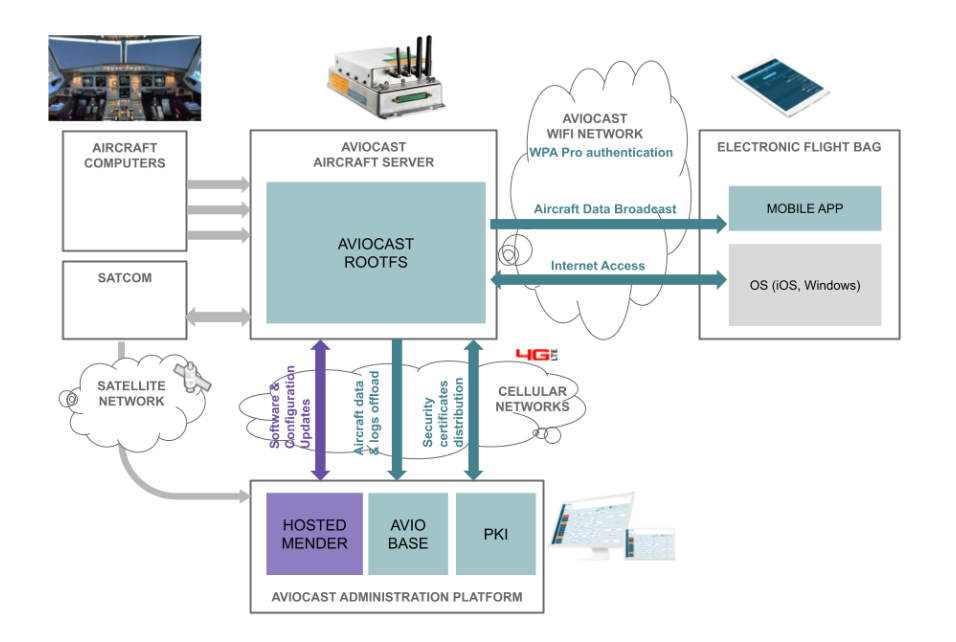The Device Chronicle interviews Remi Huynh, Product Manager, Cockpit Connectivity for Aviobook on avionics, connected aircraft communications, IoT and OTA software updates.
Aviobook was acquired by Thales in 2016. It is now a group of 100 people within Thales Avionics building digital solutions to help airlines operate in a more efficient way. The Aviobook combines cloud and smartphone applications which connect the field operators and the teams working in the back offices of the airline. Thales Avionics builds cockpit computers for large aircraft and large helicopters.

Combining digital skills with avionics expertise
Now in this new combined project focussed on cockpit connectivity, the digital agility from Aviobook is transferred to Thales Avionics, and to combine it with the knowledge of aircraft computers from Thales Avionics and this has led to the development of the Aviocast product.
In the Aviobook product, Remi explains that a number of mobile applications have been developed and dedicated to the needs of different users within the cockpit crew, the cabin operators and the mechanics working around the aircraft – repairing failures and performing diagnostics. These applications are all connected to the cloud and to the overall IT infrastructure. The Aviocast is a box that interconnects the cockpit computer with the portable electronic devices (PEDs) used by the field engineers, and also with the applications (back office and control centers) used by the back office staff. It collects aircraft data and offloads it to the ground using an embedded 4G modem or a satellite communication connection for transfer. The product also generates a wi-fi hotspot and the devices that are securely connected to the hot spot can receive a live flow of data from the aircraft computers so that for example applications can be fed and updated into the tablets.
Aviocast applications and avionics
Remi further explains that Aviobook provides internet access within the cockpit regardless of where the aircraft is, a satcom connection if the aircraft is in flight. The Aviocast box is connected to an avionics computer located with the bay of the aircraft, ands then to satcom to provide inflight connectivity, a 4G modem connects the system while it on the ground and it generates a wifi network to which the mobile devices used by the different crew connect to as alluded to above. This enables the connected aircraft operations.
The applications enabled by this connected aircraft system include:
- Weather forecast updates
- Accurate positioning on maps
- Automating crew tasks with live aircraft data feeds
- Inflight text messaging and voice calls using satellite communication
Technical architecture of the Aviocast solution in avionics
The technical architecture that enables this solution consists of the aircraft computer, satellite communication, installed in the cockpit is the Aviocast aircraft server, it generates a wi-fi network and on this wifi network, the mobile tablets from the aircraft crew or the electronic flight bag are authenticating, and the mobile applications are connecting securely to the server. In the ground infrastructure called the Aviocast Administration Platform, there are 3 main features: hosted Mender which provides for deployment of new configurations for the behavior of the server, over the air software updates and monitoring the fleet of Aviocast devices in service. Second, there are Amazon services for offloading data, and thirdly an infrastructure for certificate management – secure boot for the server, only software signed by Thales can run, security certificates for wi-fi, and certificates for Aviovast infrastructure onboard and on the ground.

The solution architecture for the Aviocast.
Importance of Mender OTA software updates to avionics
Linux Yocto is used for managing the Aviocast server, and updates are deployed using the A/B partition, when a software needs updating, the update occurs on the second partition, once the upload of the new software is completed, the device reboots, and on the new partition a self test is performed. Only when the self tests are successful then the software will update to the new version, if the self tests are unsuccessful, then the software will roll back to the previous version. In this a failure or “bricking” of the server from a failed update is achieved and this avoids any disruption to the operations. Mender was chosen to perform the full system updates over the air due to ease of use, high quality technical documentation, Mender’s ability to address Thales’ stringent security, integrity, reliability and confidentiality needs; and ultimately it saved cost by Remi and his team not having to source specialist software skills to build a homegrown OTA software updating solution which is not core to their digital product development resources. Remi says “Relying on a specialist is more efficient.”
We wish Remi and his colleagues at Thales Aviobook well as they continue to innovate in digital product development.
